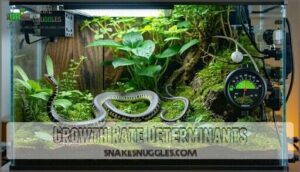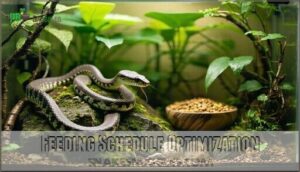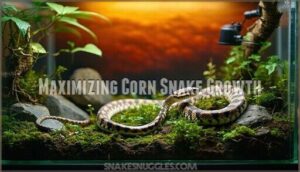This site is supported by our readers. We may earn a commission, at no cost to you, if you purchase through links.

They’ll pack on about 12-18 inches in their first year alone, then slow down as they mature.
Proper feeding every 7-10 days, maintaining temperatures between 75-85°F, and keeping humidity around 40-50% directly impacts how big they’ll get.
While genetics sets the ceiling—some lucky snakes stretch to 6 feet—most settle comfortably around 4 feet with consistent care.
The magic happens when you nail the basics: right-sized prey, steady temperatures, and patience as they transform from pencil-thin hatchlings into robust adults.
Table Of Contents
- Key Takeaways
- Corn Snake Size Factors
- How Big Do Corn Snakes Get
- Growth Rate Determinants
- Optimal Growth Conditions
- Maximizing Corn Snake Growth
- Frequently Asked Questions (FAQs)
- How fast do corn snakes grow?
- How big do corn snakes get?
- How long do corn snakes live in captivity?
- How old is a corn snake?
- How big should a corn snake be for breeding?
- Do corn snakes grow faster in captivity?
- How quickly do corn snakes grow?
- Do corn snakes bond with their owners?
- What is the biggest trouble with corn snakes as pets?
- How big does a corn snake usually get?
- Conclusion
Key Takeaways
- Your corn snake will reach 3-5 feet long within 2-3 years, with most settling around 4 feet when you provide consistent care and proper environmental conditions.
- They’ll grow fastest in their first year, adding 12-18 inches, then slow down as they mature – you’ll see the most dramatic changes early on.
- Temperature control between 75-85°F and 40-50% humidity directly impacts their final size, so maintaining these ranges helps them reach their genetic potential.
- Consistent feeding every 7-10 days with properly-sized prey determines whether your snake reaches maximum length – proper nutrition is just as important as genetics for healthy growth.
Corn Snake Size Factors
Your corn snake’s adult size depends on three main factors that work together throughout its life.
Diet quality, environmental conditions, and genetic makeup determine whether you’ll have a petite 2-foot snake or an impressive 5-foot specimen.
Diet Influence
Your corn snake’s diet directly controls its growth potential.
Proper prey selection and feeding frequency boost growth rates by 15-25%, while poor food quality stunts development.
Nutrient balance matters – protein-rich diets enhance early growth by 12-21% compared to fat-heavy options.
Consistent feeding schedules improve digestion rates and support ideal corn snake size variations throughout development.
Environmental Impact
Your snake’s surroundings directly shape its growth potential.
Temperature fluctuations, inadequate space, and poor air quality can stunt corn snake size development.
Wild populations face habitat destruction and climate change pressures that affect their growth stages.
In captivity, you’ll notice healthy corn snake growth rates improve with stable environments that mimic natural ecosystem balance through sustainable practices and proper wildlife conservation principles.
Understanding the importance of a suitable corn snake habitat is vital for providing ideal care and promoting healthy growth.
Genetic Variation
Just like people inherit height from their parents, your corn snake’s genetics play a major role in determining its maximum corn snake length.
Genetic mutations and snake morphs don’t just affect color patterns – they influence size too.
Some bloodlines consistently produce larger adults, while others stay compact.
Gene expression affects corn snake growth rate through heritability factors that determine whether your snake reaches average corn snake size or exceeds expectations for corn snake full size potential.
How Big Do Corn Snakes Get
Adult corn snakes reach impressive proportions when provided proper care. These reptiles typically measure 2-6 feet in length, with females growing larger than males.
Understanding Snake Growth Patterns helps you predict your pet’s final dimensions.
Key Corn Snake Size Facts:
- Average corn snake size: 3-5 feet for most adults
- Maximum corn snake length: Up to 6 feet in exceptional cases
- Adult corn snake length varies: Females average 4-5 feet, males 3-4 feet
- Corn snake full size: Reached between 2-3 years of age
- Corn snake size by age: Hatchlings start at 8-12 inches, gaining 12-18 inches yearly
Reptile Size Limits depend heavily on genetics and care quality. Well-fed snakes with superior husbandry reach their maximum potential, while poor Snake Feeding Habits can stunt growth permanently.
Proper care includes maintaining ideal temperature gradients to support healthy development.
Growth Rate Determinants
Your corn snake’s growth rate depends on three critical environmental factors that you can control.
Temperature gradients, UV exposure, and humidity levels work together to determine whether your snake reaches its full size potential or remains stunted throughout its life.
The combination of these factors, including temperature gradients, is crucial for the overall development of your corn snake.
Thermogradient Effects
Temperature Control becomes your secret weapon for maximizing how fast corn snakes grow.
Heat Gradients create thermal zones that boost metabolic rates by 30%, helping your snake reach maximum corn snake length faster.
Adult corn snake length increases 20% quicker with proper gradient effects.
Your snake den needs warm basking spots (30-32°C) and cooler retreat areas.
This temperature management directly impacts average corn snake size through enhanced digestion and corn snake growth stages.
It is crucial for Temperature Control and creating the right environment with heat gradients.
UV Lighting Importance
Proper lighting plays a vital role in how fast corn snakes grow during their development stages.
While corn snakes don’t require UV Benefits like some reptiles, controlled Photoperiod Effects help regulate their natural rhythms.
Standard incandescent or LED Lighting Types work well, though Spectrum Analysis shows full-spectrum bulbs can enhance overall health.
Maintain consistent Intensity Levels with 12-hour day/night cycles to support juvenile corn snake size progression through natural growth stages.
Understanding UVB lighting needs is essential for creating an ideal environment that promotes healthy growth and development in snakes.
Humidity Level Control
Maintaining 45-55% humidity supports healthy corn snake growth by preventing dehydration and shedding problems.
Use humidity sensors with hygrometer calibration to monitor levels accurately. Position water bowls appropriately and adjust ventilation control as needed.
Some keepers add fogging systems for consistency. Poor humidity affects juvenile corn snake size and creates corn snake growth problems, preventing healthy corn snake growth patterns shown in any corn snake growth chart.
Optimal Growth Conditions
You’ll achieve maximum growth potential when you nail three critical factors: proper prey sizing, consistent feeding schedules, and strategic handling practices.
Getting these elements right transforms your corn snake from a slow-growing pet into a thriving specimen that reaches its full genetic potential.
Prey Size Selection
Feeding Strategies depend heavily on Size Selection to maximize healthy corn snake growth.
You’ll need prey that’s 1.5 times your snake’s mid-body diameter—no bigger.
Hatchlings start with 1-3 gram pinky mice, then progress to fuzzies and hoppers as they grow.
Choose Prey Choice based on your snake’s length milestones, not age alone.
This approach prevents regurgitation and supports steady development.
Understanding proper snake food options is vital for healthy growth and well-being.
Feeding Schedule Optimization
Beyond choosing the right prey size, feeding frequency directly impacts your corn snake’s growth potential.
Young snakes need meals every 5-7 days, while adults thrive on 10-14 day schedules.
Consistent meal planning prevents stunted corn snake growth and supports healthy corn snake growth.
Monitor your snake’s body condition between feedings – proper snake nutrition requires adjusting food quality and timing based on age and season.
Understanding the essential snake food sources is vital for creating a well-balanced diet.
Handling and Activity Levels
Through proper Snake Handling techniques, you’ll support healthy growth by reducing stress that can impact factors affecting corn snake size.
Limit handling sessions to 10-15 minutes twice weekly, allowing your snake’s Activity Patterns and Exercise Needs to flourish naturally.
Well-designed Habitat Design promotes normal Snake Behavior, while excessive handling can contribute to stunted corn snake growth and affect corn snake lifespan and size outcomes.
Maximizing Corn Snake Growth
You’ll maximize your corn snake’s growth potential by maintaining precise temperature gradients and humidity levels throughout their development.
Creating ideal conditions requires consistent monitoring of these environmental factors to guarantee your snake reaches its full adult size within the expected timeframe, which is crucial for ensuring they achieve their maximum growth potential by maintaining precise conditions.
Temperature Management
Temperature plays a starring role in factors affecting corn snake size.
Temperature control isn’t just important—it’s the make-or-break factor that determines whether your corn snake thrives or struggles to reach its genetic potential.
You’ll want to establish thermal gradients with a basking spot at 85-88°F and cold spots around 75-78°F.
Heat control prevents temperature fluctuations that stress your snake and slow growth.
Quality heating elements like ceramic heaters or under-tank pads work best for consistent warmth that supports proper corn snake care and size development.
Proper heating equipment selection involves considering ceramic heater options to guarantee the right temperature for your pet, which is crucial for proper corn snake care and size development.
Humidity Regulation
Humidity regulation creates the perfect water balance for ideal corn snake growth and health.
You’ll want to maintain 40-60% humidity levels to support proper shedding and snake hydration without creating problems.
- Air Control: Use ventilation fans or adjustable vents to prevent stagnant, overly humid conditions that promote bacterial growth
- Humid Microclimate: Place water bowls on the warm side to create localized moisture zones without affecting the entire enclosure
- Moisture Levels: Monitor with digital hygrometers and adjust substrate moisture through misting or substrate changes as needed
Maintaining proper humidity is vital, as it involves understanding humidity control methods to guarantee the well-being of your corn snake.
Ensuring Full Growth Potential
Consistency across all care parameters creates the foundation for reaching maximum corn snake size.
You’ll need regular health checks to catch parasites or nutritional deficiencies early, as these issues can permanently stunt growth stages.
Your snake habitat should maintain stable conditions year-round, while your feeding tips focus on appropriate prey proportion to body scale.
Remember that each corn snake morph size varies genetically, so don’t expect every individual to reach BIG adult dimensions regardless of perfect enclosure design, and consider the importance of regular health checks, stable conditions, and perfect enclosure design to support growth.
Frequently Asked Questions (FAQs)
How fast do corn snakes grow?
Like tiny rockets fueled by growth hormones, your corn snake will stretch from hatchling to adult surprisingly quickly.
Young corns grow fastest during their first two years, adding 8-12 inches annually before slowing down substantially.
How big do corn snakes get?
You’ll find adult corn snakes typically reach 3-5 feet long, with some growing up to 6 feet.
They’re considered medium-sized constrictors that won’t outgrow most standard enclosures you’d set up for them.
How long do corn snakes live in captivity?
Your corn snake companion will be your faithful friend for 15-20 years in captivity, with proper care extending their lifespan like a well-tended garden blooms.
How old is a corn snake?
You can’t determine a corn snake’s exact age without knowing its birth date, but you’ll estimate based on size and growth patterns.
Juveniles measure 8-12 inches, adults reach 2-5 feet, and they grow rapidly their first two years before slowing down substantially.
How big should a corn snake be for breeding?
Maturity blooms like clockwork – your corn snake’s ready to breed when females reach 18-24 months and weigh 250+ grams, while males mature earlier at 12-18 months weighing 200+ grams.
Do corn snakes grow faster in captivity?
Yes, captive corn snakes typically grow faster than wild ones. You’ll see quicker growth because captive snakes receive consistent meals, controlled temperatures, and reduced stress from predators or environmental challenges.
How quickly do corn snakes grow?
Your snake’s growth rate depends on several factors including diet quality, temperature, and genetics.
Most corn snakes reach their adult size of 3-5 feet within 2-3 years, growing fastest during their first year when they’ll shed every 4-6 weeks and gain significant length with proper feeding.
Do corn snakes bond with their owners?
Roughly 90% of reptile behaviorists agree corn snakes don’t form emotional bonds like mammals do.
However, you’ll notice your snake recognizing your scent and becoming calmer during handling, showing basic familiarity rather than true attachment.
What is the biggest trouble with corn snakes as pets?
You’ll find their biggest challenge is escaping – they’re master contortionists who’ll slip through any gap in their enclosure.
They’re picky eaters during shedding periods and require precise temperature gradients to stay healthy.
How big does a corn snake usually get?
Like a ribbon uncoiling, your corn snake will stretch to around 3-5 feet when fully grown.
Most reach adult size within 2-3 years, with proper feeding and care accelerating their steady growth journey.
Conclusion
Remarkably, corn snakes can double their length within just six months under ideal conditions.
Understanding how big do corn snakes get and how long does it take for them to grow empowers you to create the perfect environment for your pet’s development.
You’ve learned that genetics sets the foundation, but your daily care decisions determine whether your snake reaches its full 4-6 foot potential.
Temperature consistency, proper feeding schedules, and humidity control aren’t just recommendations—they’re the blueprint for healthy growth that transforms your hatchling into a thriving adult, allowing it to reach its full potential.











